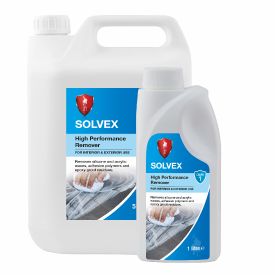
Porcelain pavers have become an incredibly popular choice for paths and patios. They bring many practical benefits, as well as providing a wide range of fabulous natural-effect finishes. But, like any new surface finish, they also bring a new set of challenges. One of the most common issues is resin staining from two-part jointing compounds.
About porcelain pavers
External pavers tend to have a matt finish and, unlike polished porcelain, they don’t need to be sealed, which is a big bonus. Most slabs also have a textured surface which gives good grip underfoot – essential in an outdoor location. However, dirt and residue from grout can easily become trapped in the ‘high-low’ surface, compromising the aesthetic, making maintenance more difficult and potentially creating a slip hazard.

About two-part jointing compounds
Two-part brush-in jointing compounds are often used for patio installations as they create a good, strong joint that can withstand the effects of pressure washers and other potential erosion. Once the grout is mixed, it has a limited working time. It’s generally applied to a wet surface and brushed into the joints. The pavers are then rinsed and swept. Often, a white residue remains on the surface of the tile which can be very difficult to remove, especially on textured surfaces. To safely remove these stains - without damaging the joint or the paver - we recommend LTP Solvex, a non-caustic intensive cleaner/stripper, which helps to soften the resin residues allowing for easier removal. Application is normally followed by a final wash with LTP Grimex cleaning solution before rinsing down.


How to use LTP Solvex & Grimex
- Pour Solvex directly onto the paver.
- Apply generously by dabbing onto stains with a cloth or brush. NB. Always wear gloves to protect your hands.
- Work in manageable areas; normally in strips as far as you can reach without treading into the solution; do not brush out.
- Leave for up to 30 minutes, but don’t allow the solution to dry out. If it starts to dry out within this time-frame, apply a little more solution.
- Use a coarse, stiff brush or LTP Black Emulsifying Pad to remove the softened coating from the surface of the paver. Repeat this process if some staining remains.
- Wash down the pavers with LTP Grimex, diluted 1:3 with water.
- Rinse with plenty of water and leave to dry.
As well as tackling brush-in grout stains, LTP Solvex can also be used to remove residual epoxy grout, wax, oil, silicone, acrylic and polyurethane sealer from porcelain, as well as stone, travertine, terracotta, slate, sandstone, flagstones, quarry tiles and glazed ceramic. Where surfaces are sealed, a sealant should be reapplied after cleaning and when the surface is sufficiently dry; this may take a minimum of 24 hours.
The benefits of a barrier treatment
To reduce the risk of staining in new patio installations, a barrier treatment can also be applied before grouting. We recommend LTP Porcelain Tile Protector which provides a number of benefits: as well as preventing grout and resins from jointing compounds taking hold, it also makes the removal of any residues much easier should they occur. The protector also helps improve and increase the working time of grouts and jointing compounds, and when a further coat is applied after installation, it makes ongoing maintenance easier too. Find out more about the treatment and link to the video aid here.

To reduce the risk of staining in new patio installations, a barrier treatment can also be applied before grouting. We recommend LTP Porcelain Tile Protector which provides a number of benefits: as well as preventing grout and resins from jointing compounds taking hold, it also makes the removal of any residues much easier should they occur. The protector also helps improve and increase the working time of grouts and jointing compounds, and when a further coat is applied after installation, it makes ongoing maintenance easier too. Find out more about the treatment and link to the video aid here.
For more expert advice and information, contact the LTP team on tel. 01823 666213 or email [email protected]



